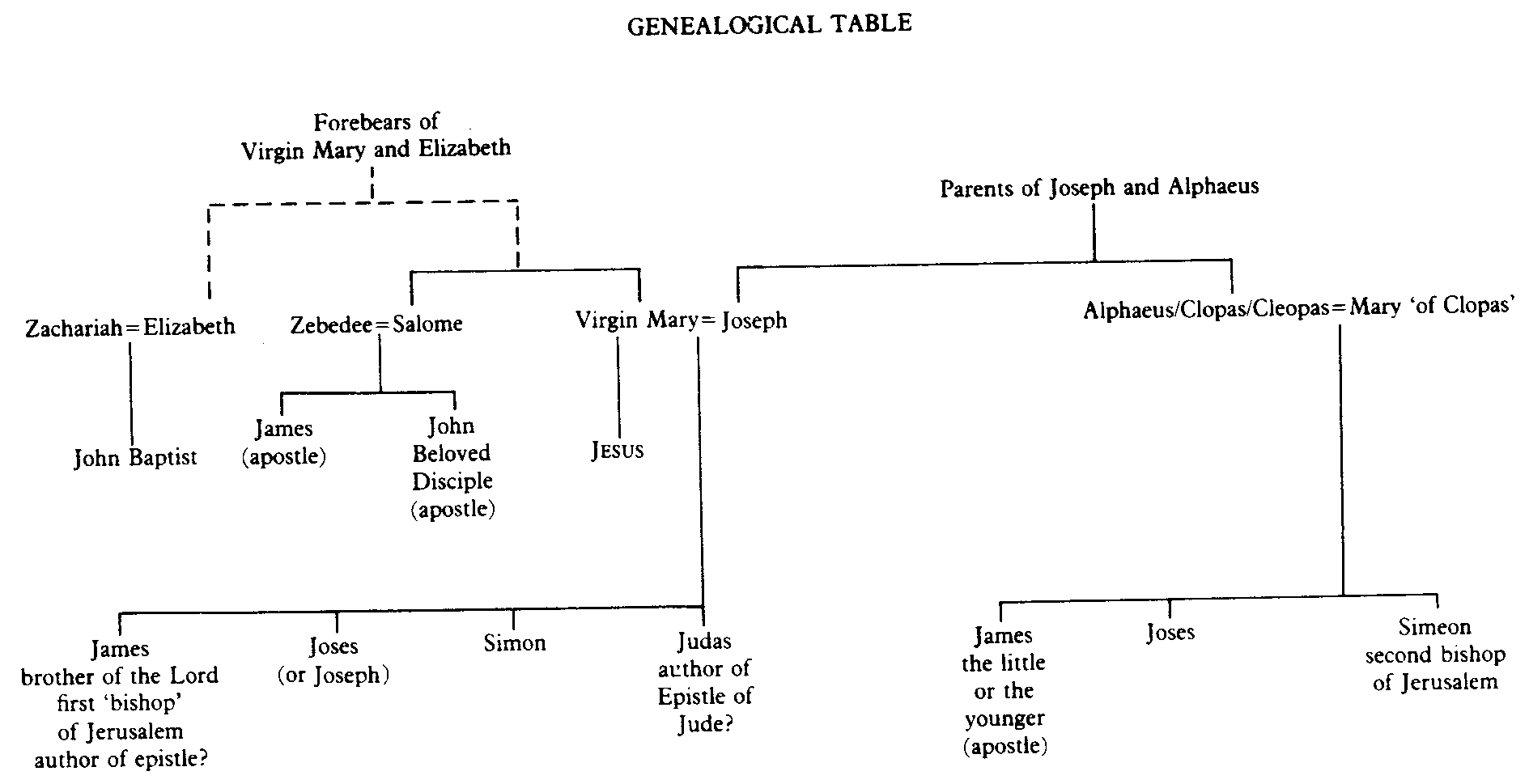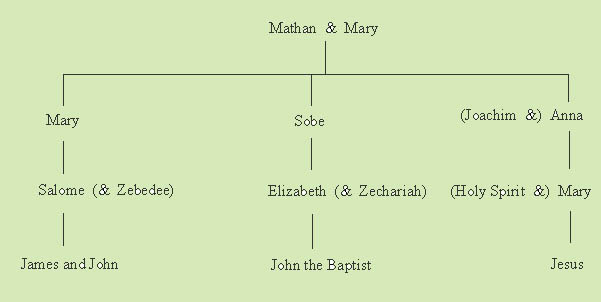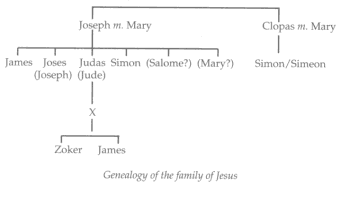Brothers of Jesus
Brothers and sisters of Jesus mentioned in the New Testament of the Bible several times. Give credit to James, Joses (or Joseph), Judas and Simon.
Biblical findings
Mentioned are the siblings at the following places in the Bible:
- Matthew: In Matthew 12.46-50 EU: A stranger says to Jesus, want to wait outside his mother and his brothers and speak to him. Jesus answered that his mother and brothers are those who do the will of His Father. It should be noted that initially the stranger introduces the waiting as the ( biological ) family of Jesus and that Jesus then the characterization of "mother" and "brothers" attaches a different meaning. In the eyes of the stranger may be waiting the actual mother and the real brothers of Jesus to him. Similarly, the situation in Luke's Gospel Lk 8,19 EU is described.
- In Mt 13,55.56 EU: Jesus occurs in Nazareth, where his family is known. Listeners outraged and talk among themselves: "Is not he the carpenter's son? Not his mother called Mary? And His brothers James, Joseph, Simon and Judas? "
- Markus: In Mk 3.31 EU: In one breath is of the Virgin Mary and the brothers of the question.
- In Mark 6:3 Jesus EU brothers are mentioned in the same breath as his mother Mary by name: James, Joses, Judas, and Simon. In addition, also sisters are mentioned. This also applies to the parallel passage in Mt 13,55 f EU
- However, the unusual first name in this form " Joses " in Mark comes twice before: Mark 15:40 LUT and LUT 15.47. The Crucifixion and burial will be in Luther's translation (1984 ) of " Mary Magdalene, and Mary the mother of James the less and of Joses " or speak of " Mary Magdalene, and Mary the mother of Joses ".
- The Gospel of John reports for this group at the time of the crucifixion: " Now there stood by the cross of Jesus his mother, and his mother's sister, Mary the wife of Cleophas, and Mary Magdalene. " ( Jn 19:25 EU). This is followed by the place, his mother entrusted to the Apostle John in Jesus. Some feel that this would be unthinkable according to Jewish custom, when Mary would have had more children.
- The first point speaks after the wedding at Cana, on the Mary, Jesus and the disciples were invited to the fact that Jesus went to Capernaum with his brothers and followers. The second passage tells of a confrontation between Jesus and his brothers.
- In the same breath, the apostles, the women, Mary the mother of Jesus, and his brothers are called. However, it immediately closes the verse that says that Peter was " the circle of brothers - one hundred twenty had come together " calling for the election of a successor to Judas Iscariot and it responds with "brothers".
- It " the brothers of the Lord " and " Cephas " are in one breath " the rest of the apostles ," called.
- Paul reported that he had seen on his first visit Jerusalem only Peter, on the other hand none of the other apostles, " except James, the Lord's brother ."
Among his " brothers and sisters ", whether in the family or kinship sense, Jesus had during his public ministry is distant. So Jesus called in contrast to his relatives in Mk 3,35 EU only those his brothers and sisters who do the will of God. The brothers Jesus deny the faith; they think he is even mad.
Only after Jesus' resurrection can be found among the disciples of his brothers (1 Cor 9.5 EU). James the Just, the most important of the head of the Jerusalem church is considered already in the early Christian tradition as a brother of Jesus, when the relationship is not clearly established. (but see a spot of Flavius Josephus in the text below ).
Linguistic analyzes
For the correct interpretation of the biblical finding also linguistic considerations used by the New Testament word comes αδελφοί adelphoi of great importance. The language spoken by Jesus and his disciples Aramaic and written or read Hebrew may have slightly different meanings of words in comparison with the Greek of the New Testament. Similarly, in the linguistic considerations of the Greek use of αδελφός / αδελφοί outside the New Testament is taken into account.
In Greek literature αδελφός is needed for biological siblings and close relatives who, as transmitted in the sense of professional Comrade, religionist, friend or fellow man.
The Hebrew word that translates the Septuagint with αδελφός is, ' oh - a term for a biological brother that is also used for other relatives, and later also for fellow. It was often claimed that neither the Hebrew nor Aramaic have a word for cousin. But a cousin is denoted by ben dod in Hebrew.
The Septuagint translated in several places of the Old Testament ' ah literally with αδελφός where ' oh denotes not a brother, but a nephew or cousin, even though the Greek words for own cousin or nephew knows: In Gen 14:12 EU will plummet, the nephew of Abraham, called his brother, in Gen 14:14 EU as his brother's son. In 1 Chronicles 24:21 f EU two brothers come before, Eleazar and Kish. Eleazar has no sons, and his daughters married their " brethren ," the sons of Kish.
In the New Testament is in some places from the context clearly distinguishable that αδελφός for male blood relatives ( Mk 6,1 ff EU, EU Jn 7.5 ), for Volksgenosse (Rom 9.3 EU) and for fellow believer (1 Cor 15.58 EU, 1 John 3:16 EU) will be used. From Mk 6,17 EU we know that αδελφός not always mean the own brother in the New Testament, because Philip is Herod's half brother. Just says Jn 19:25 EU that besides Jesus' mother was also her sister Mary. However, two biological sisters do not have the same name.
Design variants
Jesus is seen in all Christian churches, as well as anything else the Christian understanding as the firstborn son of Mary. Regarding his siblings interpretations however, divided. The main variants are
- The siblings of Jesus are biological (half) siblings, children of Mary and Joseph from Nazareth.
- The siblings of Jesus are other relatives, most commonly children of Clopas and a brother of Mary are called, so cousins of Jesus. ( The " other Mary " can not be the biological sister of the mother of Jesus, since it bears the same name. It is then possibly the wife of a brother of Mary, mother of Jesus. )
- The siblings of Jesus are children of Joseph from a previous marriage, so step-siblings (or half-sibling? ) Jesus. In this case, they were a few years older than Jesus; this view can be found, for example, in the apocryphal Protevangelium of James.
Old Church tradition
Although the early church tradition speaks of Jesus' brothers, but in addition also teaches the virginity of Mary.
The Epistle of James and Jude are attributed as early as the early church tradition James and Jude, the brothers of Jesus.
Hegesippus writes in the 2nd century by relatives of the Lord, " the grandsons of Judas, who was called his brother according to the flesh ", which had been summoned before the Emperor Domitian.
In the apocryphal Protevangelium of James from the 2nd century Joseph was before his engagement to Mary a widower with children.
Jerome referred to in the 4th century the interpretation that Mary had other children, as "new" and an insult to God.
Ambrose of Milan argues with 7,14 EU and Ez 44.1 f EU, Mary was virgin even after the birth of Jesus, which would exclude more children.
John Chrysostom explains, James, and the others were described in the same way as brothers of Jesus as Joseph was called the husband of Mary.
Augustine emphasizes that Mary "virgin during conception, virgin during birth and Jungfrau to the death " was.
The Council of Ephesus in the 5th century called Mary in its decisions as αειπαρθενος, that is, "Always young woman."
Denominational positions
Whether this acted to biological siblings or close relatives of Jesus of Nazareth, is in dispute within the Christian denominations and is designed exegetical vary according to denomination.
The Orthodox and Catholic churches hold to this day firmly believe that Mary remained virgin all her life, the siblings of Jesus are for them so either children of Joseph from a previous marriage or children of relatives of Mary. The Catholic Church has specific since the 19th century dogmas concerning the perpetual virginity of Mary.
While the Reformers still largely followed the traditional position today see many evangelical theologians the siblings of Jesus as children of Joseph and Mary. However, the issue has no importance in the Protestant theology, since no other doctrinal statements depend on it.









